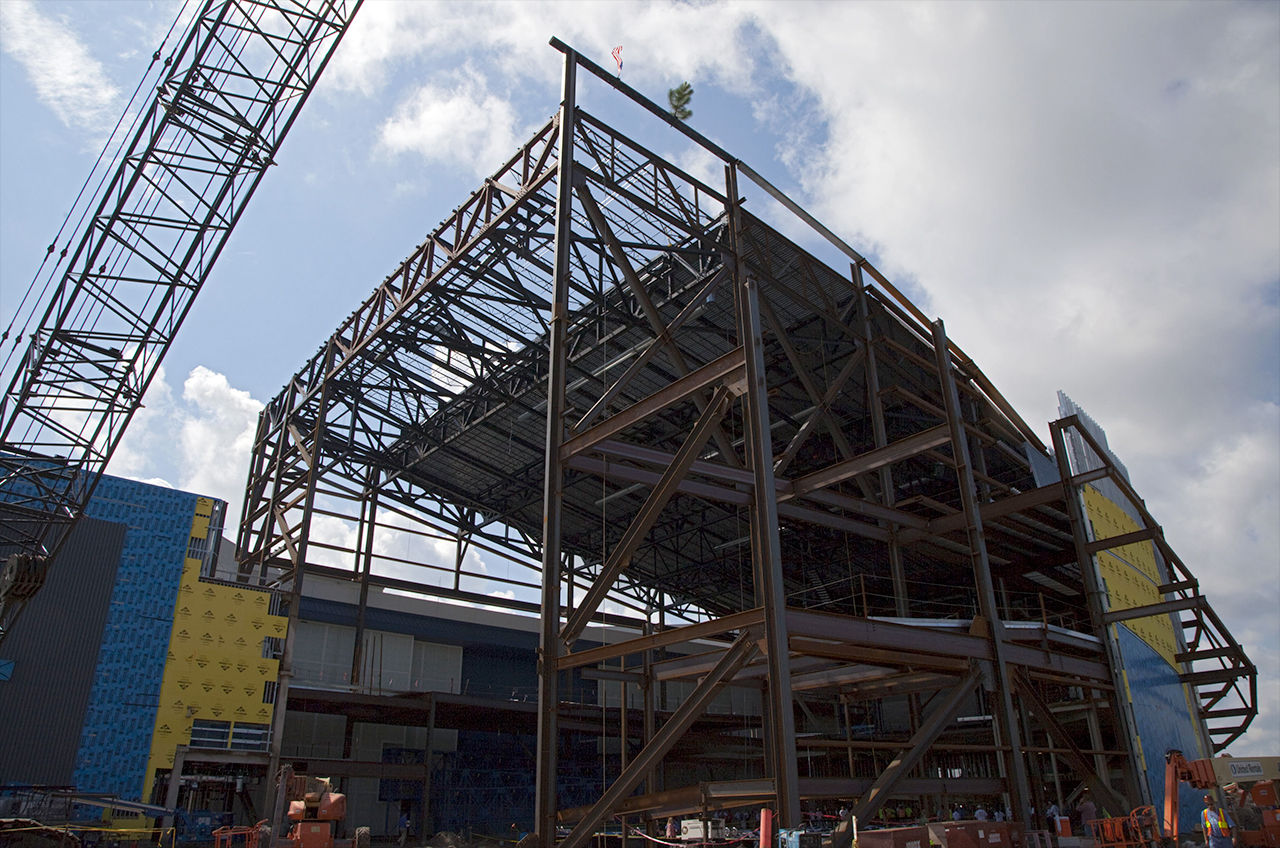Space Shuttle Exhibit Homes Topple Trees, Top Out Building

The bicoastal homes for two NASA space shuttles have raised and razed trees this week.
On Wednesday (Sept. 5), NASA's Kennedy Space Center Visitor Complex in Florida conducted a ceremonial topping out of its future home for space shuttle Atlantis. Following a centuries-old workers' tradition, the ceremony included a tree being hoisted to the top of the six-story building.
Meanwhile in Los Angeles, the California Science Center (CSC) had to topple, rather than top out, about 400 trees that were standing in the way of shuttle Endeavour arriving there next month.
Both shuttles are currently at the Kennedy Space Center, awaiting their delivery to the visitor and science centers. Endeavour will depart Florida atop a NASA jumbo jet later this month. Atlantis, which is still being converted into an exhibit piece, will be rolled over to the spaceport's nearby public attraction in early November. [Where to See America's Greatest Spaceships (Infographic)]
Topping out
Wednesday's topping out ceremony at the Kennedy Space Center Visitor Complex celebrated the overall completion of a 90,000 square foot exhibit building to display space shuttle Atlantis. The event included the lifting of the final building beam to the top of the orbiter home, eight months after first breaking ground.
"The topping out of this building is a major milestone in the construction of the future home for Atlantis," said Robert Cabana, Kennedy Space Center's director. "The team is doing a tremendous job and I can't wait to see the finished product."
Get the Space.com Newsletter
Breaking space news, the latest updates on rocket launches, skywatching events and more!
"Atlantis is going to look spectacular in her new home," he said in a statement.
The $100 million exhibit will share the story of NASA's 30 year shuttle program, while offering a unique vantage point for guests to look at Atlantis up-close.
The 115-foot-tall (35 meters) exhibit building was designed to comprise two sweeping architectural elements, or wings, to represent the space shuttle's launch and landing. The outer layer of the hall will be cloaked in iridescent hues of orange and gold to symbolize the fiery glow of reentry into Earth's atmosphere. The taller, internal wing of the building will be covered in a shimmering tile pattern to evoke the tiled underside of the shuttle.
Upright replicas of the shuttle's external fuel tank and twin solid rocket boosters will stand at the building's entrance. On the opposite side of the assembly, a silhouette of the orbiter will provide guests an idea of the shuttle's size and placement when it was on the launch pad.
The real Atlantis, which moved into an Orbiter Processing Facility hangar last month to undergo final transformation from a space-worthy vehicle to a museum-safe display, is scheduled to roll atop a wheeled transporter to the visitor complex on Nov. 2. Once contained within its new exhibit building, workers will erect the final wall to encase Atlantis inside
Atlantis, which flew NASA's 135th and final mission of the shuttle program in July 2011, is set to debut to the public at the visitor complex in July 2013.
Toppling down
Space shuttle Endeavour is set to leave Kennedy Space Center atop NASA's modified Boeing 747 Shuttle Carrier Aircraft (SCA) on Sept. 17, weather permitting. The orbiter and aircraft combo will cross the country over three days, landing at Los Angeles International Airport (LAX) on Sept. 20.
Endeavour, which flew to space 25 times, will embark on "Mission 26: The Big Endeavour" on Oct. 12-13. The two day road trip through the streetsof Inglewood and L.A. will roll the shuttle atop a modified NASA transporter from the airport to the California Science Center (CSC).
"This will mark the first, last and only time a space shuttle will travel through 12 miles of urban, public streets," said Jeffrey Rudolph, CSC's president, in a statement. "It's not only one of the biggest objects ever transported down city streets; it's an irreplaceable national treasure."
To protect their treasure and to make sure the five story tall, 78-foot wide (24 meter) shuttle can clear the planned route, the CSC is having light fixtures and power lines temporarily removed, as well as having about 400 trees cut down.
According to the Los Angeles Times, 128 trees lining the streets in Inglewood and about 265 alongside roadways in L.A. are being trimmed and toppled. Many of the trees were already under consideration for removal, including 91 that bordered an airport fence.
"While we welcome the space shuttle with open arms, we recognize the effect it'll have on surrounding communities and are working hard to mitigate those impacts," said Los Angeles Mayor Antonio Villaraigosa in a statement.
For every tree brought down, the CSC plans to plant two in its place. The science center is investing $500,000 toward landscaping and roadway improvements after Endeavour passes through.
Once the shuttle arrives at the CSC, it will be temporarily housed in the recently-completed Samuel Oschin Space Shuttle Endeavour Display Pavilion. By 2017, the center plans to build the Samuel Oschin Air and Space Center to display Endeavour as if it was on the launch pad, standing vertically and paired with a replica of an external fuel tank and twin solid rocket boosters.
See shuttles.collectspace.com for continuing coverage of the delivery and display of NASA's retired space shuttles.
Follow collectSPACE on Facebook and Twitter @collectSPACE and editor Robert Pearlman @robertpearlman. Copyright 2012 collectSPACE.com. All rights reserved.
Join our Space Forums to keep talking space on the latest missions, night sky and more! And if you have a news tip, correction or comment, let us know at: community@space.com.

Robert Pearlman is a space historian, journalist and the founder and editor of collectSPACE.com, a daily news publication and community devoted to space history with a particular focus on how and where space exploration intersects with pop culture. Pearlman is also a contributing writer for Space.com and co-author of "Space Stations: The Art, Science, and Reality of Working in Space” published by Smithsonian Books in 2018.In 2009, he was inducted into the U.S. Space Camp Hall of Fame in Huntsville, Alabama. In 2021, he was honored by the American Astronautical Society with the Ordway Award for Sustained Excellence in Spaceflight History. In 2023, the National Space Club Florida Committee recognized Pearlman with the Kolcum News and Communications Award for excellence in telling the space story along the Space Coast and throughout the world.









